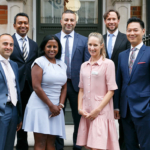Call me back
- Procedures
- Conditions
- Consultants
- Ms Masara LaginafSpecialist Area: Laser eye surgery, lens surgery, corneal surgery
- Ms Rabia BourkizaSpecialist Area: Vitreoretinal surgery, cataract surgery
- Ms Laura de Benito-LlopisSpecialist Area: Laser eye surgery, lens surgery, corneal surgery
- Mr Mark WilkinsSpecialist Area: Laser eye surgery, lens surgery, corneal surgery
- Ms Susan SarangapaniSpecialist Area: Cosmetic eyelid surgery
- Ms Sally AmeenSpecialist Area: Glaucoma treatment, cataract surgery
- Mr Chien WongSpecialist Area: Vitreoretinal surgery
- Mr Ali MearzaSpecialist Area: Laser eye surgery, lens surgery, corneal surgery
- Mr Romesh AngunawelaSpecialist Area: Laser eye surgery, lens surgery, corneal surgery
- Mr Allon BarsamSpecialist Area: Laser eye surgery, lens surgery, corneal surgery
- View all consultants
- About us
- Who We Are
- What We Do
- Our Impact
- About OCL VisionWe deliver first-class eye treatments across London and Herts.
- Locations
- FAQ
- Prices & finance
- Self PayFind information on our prices and payment options.
- Payment PlansMonthly payment plans to suit every budget, world-class eye surgery from just £37 per month.
- Private InsuranceWe are a registered facility with the majority of UK and international private medical insurers.
- Laser eye surgery pricesFind more information on the cost of laser eye surgery and what is included.
- Cataract surgery pricesFind more information on the cost of private cataract surgery and what is included.
- Contact us
- Refer your patient
- Procedures
- Conditions
- Consultants
- Ms Masara LaginafSpecialist Area: Laser eye surgery, lens surgery, corneal surgery
- Ms Rabia BourkizaSpecialist Area: Vitreoretinal surgery, cataract surgery
- Ms Laura de Benito-LlopisSpecialist Area: Laser eye surgery, lens surgery, corneal surgery
- Mr Mark WilkinsSpecialist Area: Laser eye surgery, lens surgery, corneal surgery
- Ms Susan SarangapaniSpecialist Area: Cosmetic eyelid surgery
- Ms Sally AmeenSpecialist Area: Glaucoma treatment, cataract surgery
- Mr Chien WongSpecialist Area: Vitreoretinal surgery
- Mr Ali MearzaSpecialist Area: Laser eye surgery, lens surgery, corneal surgery
- Mr Romesh AngunawelaSpecialist Area: Laser eye surgery, lens surgery, corneal surgery
- Mr Allon BarsamSpecialist Area: Laser eye surgery, lens surgery, corneal surgery
- View all consultants
- About us
- Who We Are
- What We Do
- Our Impact
- About OCL VisionWe deliver first-class eye treatments across London and Herts.
- Locations
- FAQ
- Prices & finance
- Self PayFind information on our prices and payment options.
- Payment PlansMonthly payment plans to suit every budget, world-class eye surgery from just £37 per month.
- Private InsuranceWe are a registered facility with the majority of UK and international private medical insurers.
- Laser eye surgery pricesFind more information on the cost of laser eye surgery and what is included.
- Cataract surgery pricesFind more information on the cost of private cataract surgery and what is included.
- Contact us
- Refer your patient
